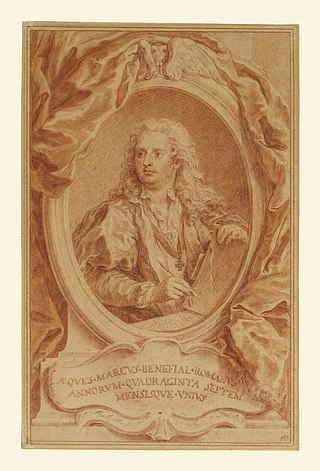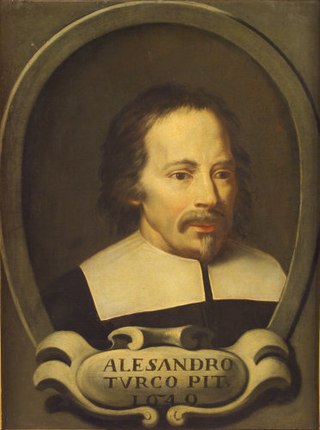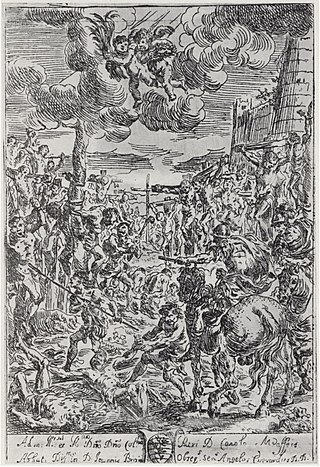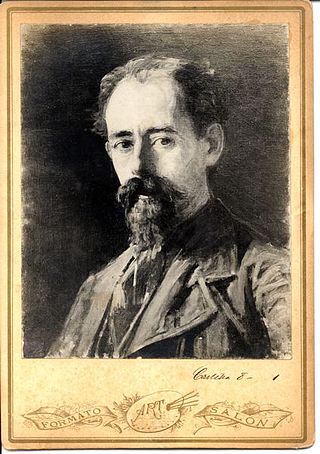
The Basilica of Saint Francis of Assisi is the mother church of the Roman Catholic Order of Friars Minor Conventual in Assisi, a town in the Umbria region in central Italy, where Saint Francis was born and died. It is a papal minor basilica and one of the most important places of Christian pilgrimage in Italy. With its accompanying friary, Sacro Convento, the basilica is a distinctive landmark to those approaching Assisi. It has been a UNESCO World Heritage Site since 2000.

The Master of Saint Francis was an anonymous Italian painter, perhaps of Pisan origin though probably trained in Umbria, working between 1250–1280. His work embodies an important aspect of the Italo-Byzantine style resulting from contact between Italian and Byzantine art of this period.

Castelsardo is a town and comune in Sardinia, Italy, located in the northwest of the island within the Province of Sassari, at the east end of the Gulf of Asinara. It is one of I Borghi più belli d'Italia.

Marco Benefial was an Italian proto-Neoclassical painter, mainly active in Rome. Benefial is best known for his repudiation of 18th century decorative Rococo styles pre-eminent in the Rome dominated by Carlo Maratta pupils. His paintings portrayed tangible human figures, with complex treatment of space, and luminous, warm colors. Along with the altarpieces and frescoes, he also painted many portraits. Because he partnered with some inferior artists who subsequently received credit, some of his paintings have been frequently misidentified.

Gioacchino Assereto was an Italian painter of the early Baroque period and one of the most prominent history painters active in Genoa in the first half of the 17th century.

Guglielmo Borremans or Guglielmo Fiamingo (1670–1744) was a Flemish painter whose documented career took principally place in Italy, in particular Naples, Cosenza and Sicily. Here he was one of the pre-eminent late-Baroque fresco painters of the first half of the 17th century who received multiple commissions to decorate churches and palaces.

Alessandro Turchi was an Italian painter of the early Baroque, born and active mainly in Verona, and moving late in life to Rome. He also went by the name Alessandro Veronese or the nickname L'Orbetto. His style has been described as soft and Caravaggesque at the same time.

Angelo Everardi was a painter and printmaker active in Brescia in the second half of the 17th century. No paintings have been attributed to him with certainty. He is reported to have been a painter of battle scenes, Bambocciate, i.e. low life genre scenes as well as of history paintings.

The Master of the Osservanza Triptych, also known as the Osservanza Master and as the Master of Osservanza, is the name given to an Italian painter of the Sienese School active about 1430 to 1450.

Maestro della Cappella di Santa Margherita a Crea, or more simply Maestro di Crea, is the name given to the anonymous Italian painter who was engaged by Guglielmo VIII Paleologo, Marquis of Montferrat, to decorate the chapel of Santa Margherita in the Santuario della Madonna di Crea near Serralunga di Crea. The work was performed during the years 1474–1479. The sanctuary stands on the highest hill of the Basso Monferrato; later it would form the focal pont of the Sacro Monte di Crea.

The Isaac Master was an Italian Gothic painter active in the decoration of the Basilica of San Francesco d'Assisi in Assisi at the end of the thirteenth century. Master's name is derived from a fresco painting of the death of Isaac for which he is known, the fresco is located in the Upper Church of St Francis at Assisi, depicting Isaac blessing Jacob and Esau.

Castelsardo Cathedral is a cathedral in Castelsardo, northern Sardinia, Italy, and is dedicated to Saint Anthony the Great. It became the seat of the bishop of Ampurias in 1503. In 1839 the diocese of Ampurias was merged into that of Tempio, and the episcopal seat moved to Tempio Cathedral, when that of Castelsardo became a co-cathedral, as it remains in the present diocese of Tempio-Ampurias.
Giovanni Battista Ciolina was an Italian neo-impressionist and divisionist painter.

Gioacchino Toma was an Italian art instructor and painter, noted primarily for historic, realistic and genre subjects in a Romantic style.

Master of Città di Castello, in Italian, Maestro di Città di Castello, was an anonymous painter of Medieval art. Mason Perkins is responsible for his identification and naming in 1908, based on the styling from the Master preserved at the Pinacoteca comunale, Città di Castello, in Umbria.

Domenico di Zanobi, formerly known as the Master of the Johnson Nativity, was an Italian Renaissance painter. His exact dates of birth and death are not known. He is documented as a mature artist from 1467 until 1481.

Maestro della Fertilità dell'Uovo or Master of the Fertility of the Egg is the name given to a yet to be identified painter active in the second half of the 17th and early 18th century in Brescia. The name is based on a work entitled La fertilità dell' Uovo, which depicts dwarfs, geese and lobsters hatching eggs and is in the collection of the Milwaukee Art Museum.
The Diocesan Museum of Palermo is a museum of religious art in Palermo on Sicily, housed in a number of rooms in the Palazzo Arcivescovile opposite Palermo Cathedral.

Gioacchino de' Gigantibus or Gioacchino di Giovanni was an illuminator, miniaturist and copyist active in Italy. Originally from Bavaria, he probably learned his trade in Florence. Around 1450 he moved to Rome, where he received commissions from high-ranking church officials. In his life, he would eventually work for six different popes. In the 1460s he also spent time in Siena, and moved to the court of Ferdinand I of Naples in Naples in 1471. In the early 1480s he returned to Rome, where he is mentioned for the last time in 1485.

















